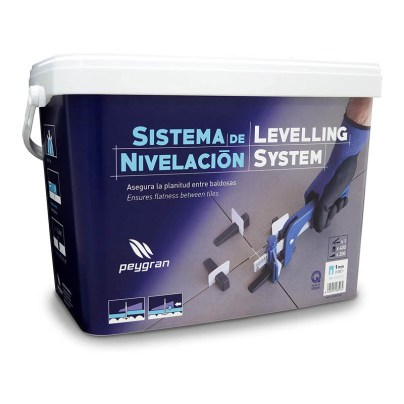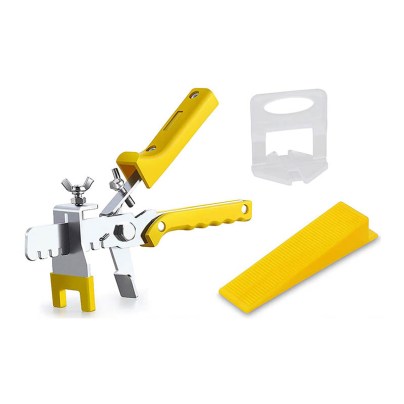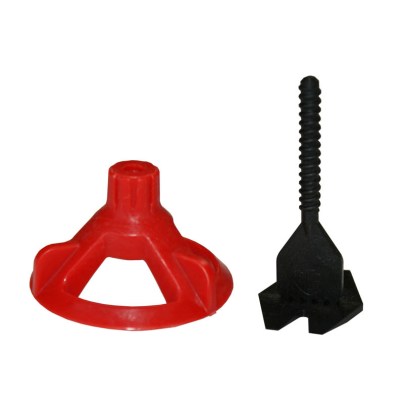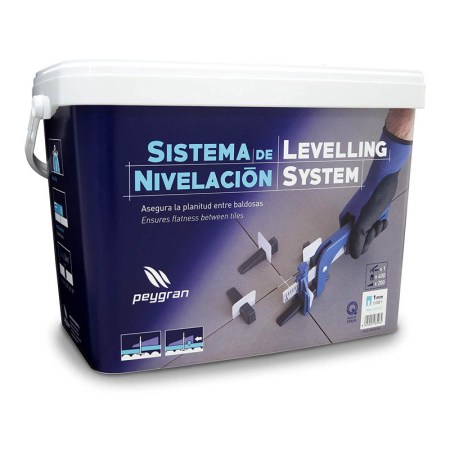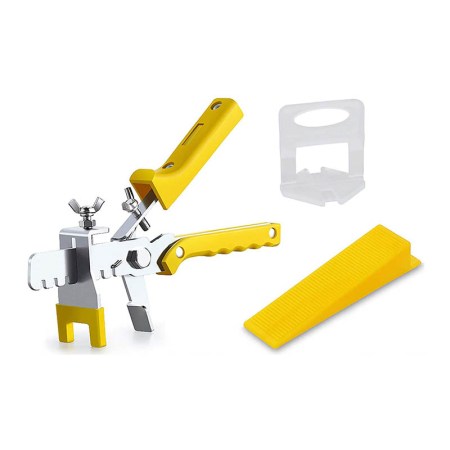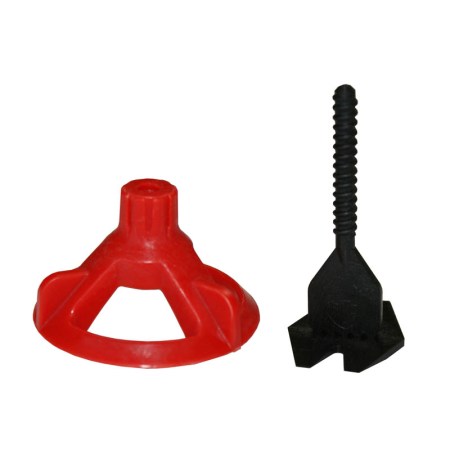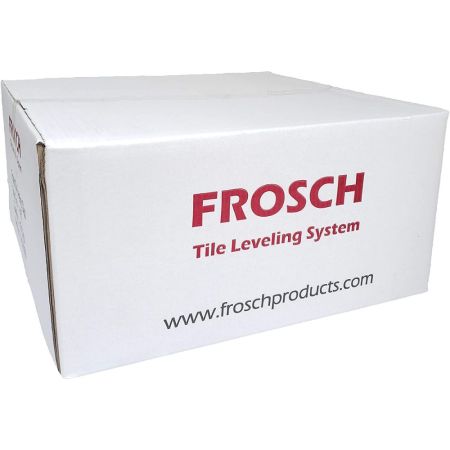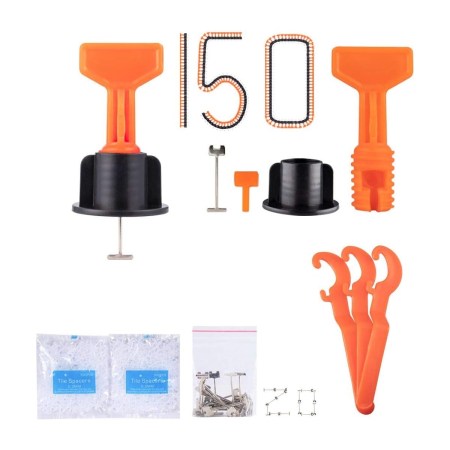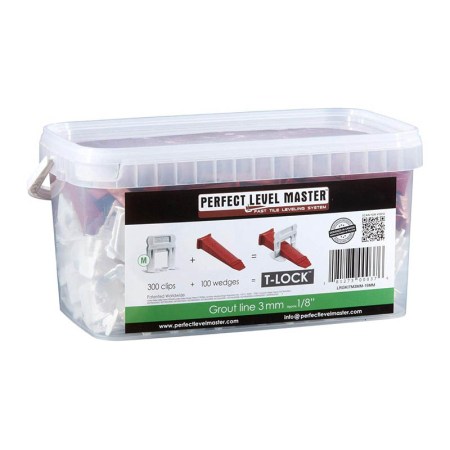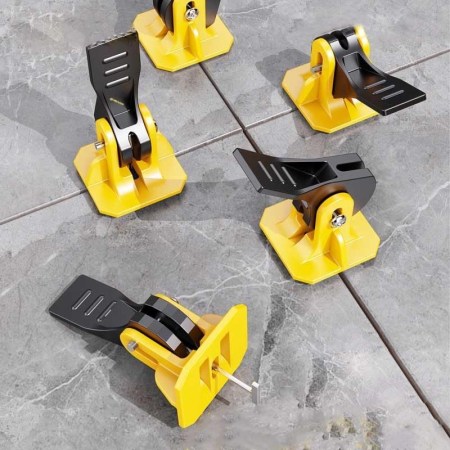We may earn revenue from the products available on this page and participate in affiliate programs. Learn More ›
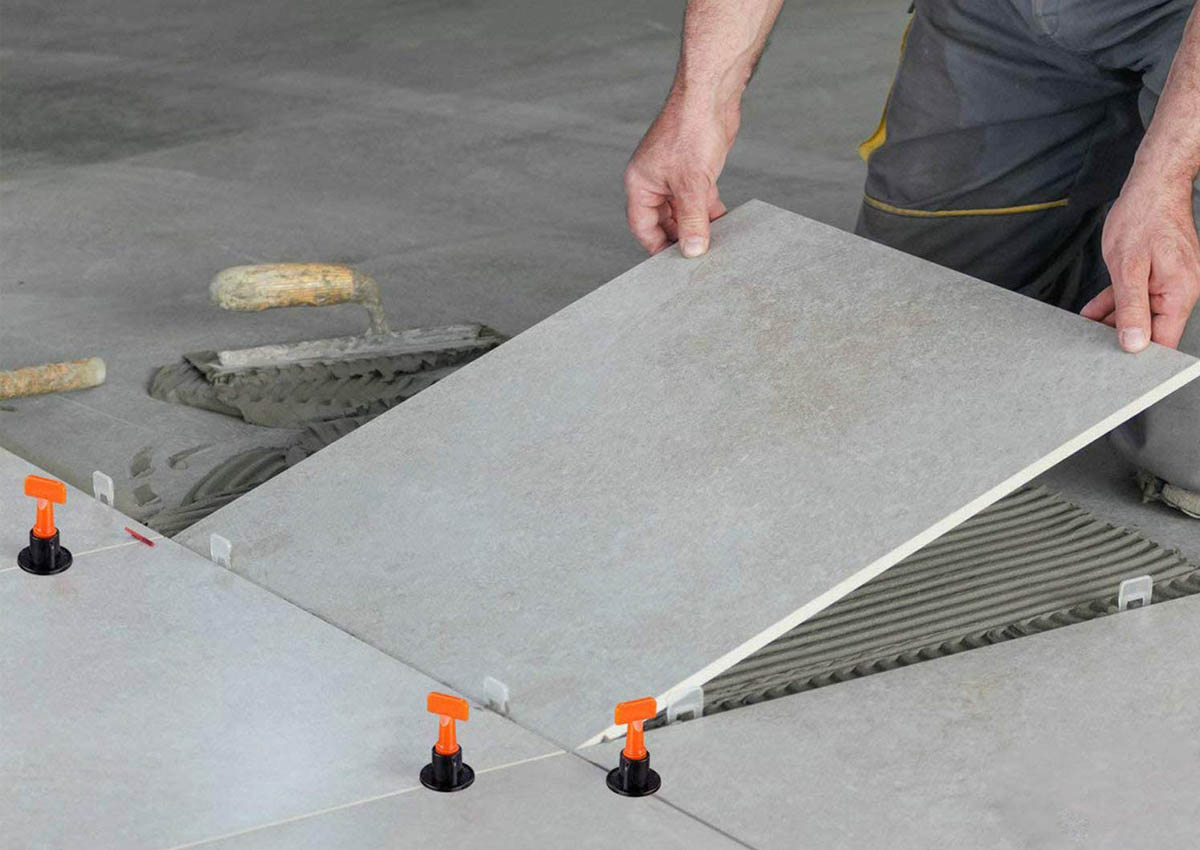
Tile offers an extensive range of style and design possibilities for your walls and floors. While it may seem that tiling requires high levels of skill to achieve a consistent finish, there are products that can help. With the right preparation and a good leveling system, tiling is a challenge anyone can tackle.
The following are some of the top picks to consider when shopping for the best tile leveling system for your next project.
- BEST OVERALL: Peygran Tile Leveling System Starter and Super Kit
- BEST BANG FOR THE BUCK: DGSL 300-Piece Tile Leveling System
- BEST FOR WALL: Spin Doctor 250-Piece Tile Lippage Control System
- BEST FOR LARGE-FORMAT: Frosch 2,000-Piece Tile Leveling Clips
- BEST FOR DIY: GenericBrands Tile Leveling System
- BEST FOR PROFESSIONALS: Perfect Level Master T-Lock Clips
- BEST FOR BEGINNERS: Facite Tile Leveling System
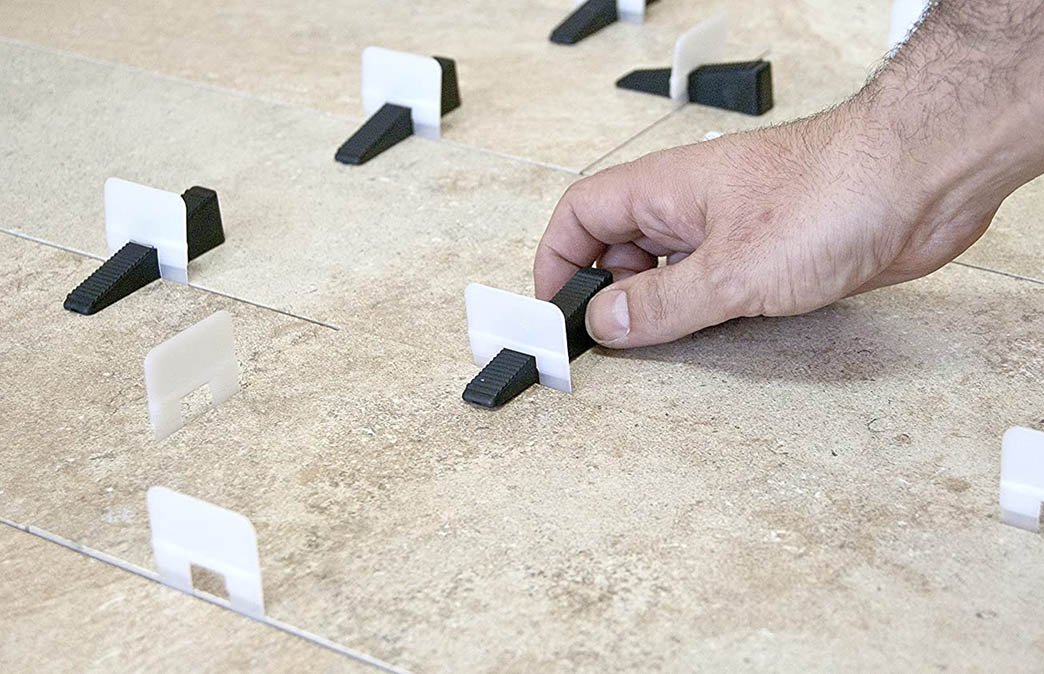
How We Chose the Best Tile Leveling Systems
In our research, we found that the factors that make for a great tile leveling system include ease of use, compatibility with types of tiles and grout thickness, and other special features.
Our list includes clip-and-wedge systems (also known as wedge tile leveling systems) as well as rotating-cap options that can accommodate any user’s preference. Many of our top picks have durable plastic or metal construction, making them suitable for DIY and professional use. Our choices also have a grout-line thickness that ranges between ⅛ inch to up to 12 millimeters, making it possible to reuse many of these options for more than one tile leveling process.
We reached out to the National Tile Contractors Association based in Jackson, Mississippi, for their input. Director Mark Heinlein says, “Lippage control devices (what the pros call tile leveling systems) serve two functions: to hold the tiles in place while the bond coat cures and to help reduce the human error component. “ He goes on to advise that “you still need to ensure proper bond coat coverage (mortar or thinset) along the sides and corners of the tile to support these most vulnerable areas, and to select a lippage control device that does not interfere with the bond of the tile to the substrate.”
Our Top Picks
A great tile leveling system makes any tiling project a cinch. Here are our top choices.
Best Overall
Peygran Tile Leveling System Starter and Super Kit
See ItProduct Specs
- Method: Clip and wedge
- Tile thickness: Not listed
- Spacer thickness: ⅛, 1/16, and 1/32 inches (depending on kit)
Pros
- This kit comes with clips, reusable wedges, and the necessary pliers
- Patented design; adjusts to the floor tiles’ thickness for added ease of use
- Concise instructions included with purchase; suitable for professionals or first timers
- Clips break off cleanly and easily when grouting is to be done
Cons
- Clips may move easily while in place; caution advised while in use
The Peygran tile leveling system uses clip-and-wedge components that are quick and simple to install. Concise instructions are provided so even those with no prior knowledge of tiling can get started right away.
Available in two sizes, this kit contains everything needed for a substantial tiling job, including clips or spacers, reusable wedges, and the necessary pliers. It has a patented design that adjusts to the tile thickness, so there’s no guesswork. It’s all provided in a handy plastic tub.
What sets the Peygran tile system apart from others is its quality and precision. The pliers prevent the application of too much pressure. The ⅛-inch thick clips, for example, have great uniformity and break off cleanly when it’s time for removal so grouting can begin without delay. Equally effective for wall or floor tiles, the system is easy to use for those new to tiling, yet it’s accurate enough for the professional.
Get the Peygran tile leveling system at Amazon or Peygran.
Best Bang for the Buck
DGSL 300-Piece Tile Leveling System
See ItProduct Specs
- Method: Clip and wedge
- Tile thickness: Between ⅛ and ½ inch
- Spacer thickness: ⅛ inch
Pros
- 3 tile-spacer sizes available; comes with 300 clips, 100 reusable wedges, and pliers
- Can be used for both floor and wall tiles’ leveling projects
- All clips and wedges are reusable; designed for DIYers as well as professionals
Cons
- The included pliers may not be suitable for heavy-duty applications
- Some of the components included may not be as durable as some comparable models
At first glance, it’s difficult to tell the DGSL tile leveling system from kits that cost two or three times more. Available in ⅛, 1/12, or 1/16 tile spacer sizes, this tile leveling system includes 300 clips, 100 reusable wedges, and pliers. This enables fitting wall or floor tiles from ⅛ inch to ½ inch thick. In principle, this tile leveling system is as quick and easy to use as any other of our top picks. However, the included pliers aren’t quite as well made, so more care is required when working with them, possibly making tiling jobs take longer.
The DGSL tile leveling system is known for its affordable price point. However, some users have reported that the clips may not always detach cleanly, which can require additional effort to achieve a polished finish. With proper trimming techniques, tile damage can usually be avoided. Despite its occasional limitations, many users find that the DGSL tile leveling system provides excellent value for the cost.
Get the DGSL tile leveling system at Amazon.
Best for Walls
Spin Doctor 250-Piece Tile Lippage Control System
See ItProduct Specs
- Method: Rotating cap
- Tile thickness: Up to ¾ inches
- Spacer thickness: ⅛, 1/16, 1/32, and 3/16 inches
Pros
- Includes 100 reusable caps and 250 base plates; great for DIY projects or professional use
- Large-diameter spinner applies pressure evenly; uneven tiles will be seen easily with the naked eye
- Can be inserted into near corners and be used as joints between tiles
Cons
- May not be the best option for stone flooring varieties
- Threaded clips are not reusable
The Spin Doctor 250-piece tile lippage control system from RTC Products is unique in that it uses a disposable threaded clip with a reusable spinner that winds down to apply pressure. It takes a little longer to wind the spinner than it does to insert wedges, but an extra tool isn’t required. The large-diameter spinner also applies pressure more evenly across adjacent tiles and, it could be argued, with greater control.
The clip’s design means it can be inserted not just near corners, as is the case with wedge systems, but also at joints between tiles. Tiles on walls are more prone to movement, so using additional fixings can help prevent this.
Transparent shields, which fit between the spinner and the tile surface, are available as an extra purchase and give added protection to delicate tile surfaces.
Get the Spin Doctor tile leveling system at Amazon or Walmart.
Best for Large-Format
Frosch 2,000-Piece Tile Leveling Clips
See ItProduct Specs
- Method: Clip and wedge
- Tile thickness: Between ⅛ and ½ inch
- Spacer thickness: 1/16 inch
Pros
- Includes 2,000 heavy-duty plastic clips for measuring very large surface areas
- Durable plastic clips won’t break if bent, twisted, or stepped on
- Can be reused if necessary; suitable for use on floor tile as well as walls
Cons
- Only 10 wedges included, so pliers and wedges need to be added to cost
The weight and thickness of large-format tiles often pose an extra challenge when laying tile. There’s a tendency for the tile to sink into the
, exaggerating lippage. More force may be required to correct this, and thin clips can fracture during setting.
This 2,000-piece tile leveling system has durable plastic clips that won’t break and can be reused on either the floor or a wall. They accommodate grout lines that are up to 1/16 inch wide and tile thickness between ⅛ and ½ inch.
Get the Frosch tile leveling system at Amazonor Frosch.
Best for DIY
GenericBrands Tile Leveling System
See ItProduct Specs
- Method: Rotating cap
- Tile thickness: 3 to 17 millimeters
- Spacer thickness: 1/12 and 1/16 inch
Pros
- Easy-to-use system that’s ideal for all kinds of DIY tasks
- Compatible with a wide range of tile sizes and grout thicknesses
- Durable plastic components and reusable stainless steel needles for better economy
- Available in 150-, 200-, or 300-pack quantities to suit different tile projects
Cons
- Some users report that the pins can be difficult to remove
The GenericBrands tile leveling system will appeal to DIY users for several reasons. Those with little experience will be delighted with how easy the rotating clips are to install and adjust. Those with one or two tiling projects under their belt will appreciate the versatility and the fact that pack sizes of 150, 200, and 300 are available, so there’s no need to buy more than a particular job demands.
Tile gaps between 2- and 6-millimeter tile thicknesses up to a heavy-duty 17 millimeters can be accommodated. A spanner is included and can turn the durable plastic caps with little effort but great precision, thus making it easy to eliminate lippage.
Get the GenericBrands tile leveling system at Amazon.
Best for Professionals
Perfect Level Master T-Lock Clips
See ItProduct Specs
- Method: Clip and wedge
- Tile thickness: ⅛ to 5/16 inch
- Spacer thickness: ⅛ inch
Pros
- Suitable for professional use; allows for accuracy and speed while leveling
- Available in packs of 100, 250, 500, and 1,500 for different tiling tasks
- 3 clip sizes available, with tile thickness ranging between 3 and 25 millimeters
- Large size is easy to place or remove when needed
Cons
- Pliers are recommended for precision and accuracy while in use
Available in three clip height sizes, Perfect Level Master T-lock clips are a high-quality clip-and-wedge tile leveling system that’s popular with professionals because it allows for both accuracy and speed. Although more expensive than many competitors, the consistent clip size and reliable shear performance provide significant time savings for the tile contractor.
T-Lock clips are available in packs of 100, 250, 500, and 1,500. The toe of the wedges has an unusual stepped pattern, so they can double as tile spacers. They are quick and easy to remove because they are considerably larger than the small plastic pieces usually used, which is another significant time-saver.
Although the wedges can be
and pliers aren’t necessary, less experienced users may prefer to use pliers.
Get the Perfect Level Master tile leveling system at Amazon or Perfect Level Master (for clips only).
Best For Beginners
Facite Tile Leveling System
See ItProduct Specs
- Method: Pin and lever
- Tile thickness: 8 to 12 millimeters
- Spacer thickness: ⅛ inch
Pros
- Uses a lever action that the manufacturer claims is quicker and easier than that of other systems
- No need to rotate cap multiple times, push in wedges, or use pliers
- Durable thermoplastic body and replaceable steel pins offer good long-term value
- Equally suitable for large and small format tiles on walls or floors
Cons
- Pins must be removed before thinset is fully hard, so not safe to leave overnight
It’s easy to understand why beginners are intimidated by tiling, but modern leveling systems make the job a great deal easier. This one from Facite is arguably the quickest and easiest of all. No tools are required, which helps even complete novices create a professional finish.
The Facite system uses steel pins much like those in rotating cap levelers, but instead of having to worry about how far a screw is turned, the simple lever adjusts tiles to a preset level in one smooth action. There are 50 durable thermoplastic levers and 50 steel pins included in the pack with additional pins readily available at minimal cost.
Get the Facite tile leveling system at Amazon.
Jump to Our Top Picks
What to Consider When Choosing a Tile Leveling System
While all tile leveling systems perform a similar function, there are variations in how they achieve a level surface. There are also differences in quality. Here are some key features shoppers may want to consider when searching for the best tile leveling system.
Method
The main challenge when laying tile is lippage: the misalignment of tile edges that spoils the finished look of walls and floors. Tile spacer leveling systems combat this by allowing users to insert clips between tiles, then applying pressure to pull them into alignment. The method and specific steps of a tile leveling system depend on the product. However, there are two different methods: the clip-and-wedge system or applying pressure using a rotating cap.
The clip-and-wedge method uses a crosshead, which is a plastic clip that sits between the tiles. It has a slot for a wedge. After the wedge is inserted into the slot, pressure is applied either by hand or with special pliers.
Another method involves applying pressure using a rotating cap. There are two variations to this method: tightening by hand or using the special wrench that’s included in the kit.
When selecting a system based on method, be careful when you see the term “T-Lock.” It’s sometimes used to describe the second type of tile leveling system, but it’s also the name of a leading manufacturer of the first type.
Ease of Use
Tile leveling systems are usually quite straightforward, but there are differences based on the ease of use.
The wedge tile leveling system is faster, but control of pressure isn’t as accurate. Care is needed not to insert the wedge too far. If that happens, the tile will need to be lifted and reset. There’s also a difference when it comes time to remove the clips. Systems that involve wedges are designed to break off below the grout line. This can be done after the adhesive has set. Wedges are fast and, once set, can be left until it’s convenient to remove them.
When using the rotating cap system, the use of a hand screw or wrench allows more precise application of pressure so accidental overtightening is less likely. T-pins are a little more forgiving for the beginner, but they take longer to set up. It’s also necessary to return to the job 3 or 4 hours later to remove the T-pins, as they have to be removed before the mortar or thinset has completely hardened. If the adhesive sets, the T-pins will be trapped and the wall or floor may be ruined.
Tile and Grout Thickness
With clip-and-wedge systems, the clips are available in different thicknesses. They can double as both tile leveler and spacer, though it’s not necessary. The ⅛-inch clips are the most common size, but for a larger gap and a thicker grout line, there are separate spacers that can be cheaper than buying different clips.
The gap in the clip for wedge insertion defines the maximum tile thickness that can be accommodated, and sizes are often stated in metric units. Usually these are between 3 millimeters (about ⅛ inch) and 12 millimeters (about ½ inch).
T-pins are a fixed size, frequently ⅛ inch thick. However, they should never be used as spacers for consistent grout lines, so those need to be purchased separately. In general, T-pins allow for thicker tiles up to 17 millimeters (about ⅝ inch).
Quality and Value
Tile leveling systems are affordable, but there can be notable differences in price and what is included in a kit.
When making comparisons among products, check the quantity provided and whether the kit includes everything needed to complete the project. Some clip-and-wedge kits include pliers that are usually required for use. The wedges in these kits are reusable, but the clips are consumable items. For kits with T-pins, undamaged T-pins can be reused many times. If buying a T-pin system, it’s important to have tile spacers, but these are frequently included.
Some companies’ products are renowned for their quality, which is based on consistent thickness of clips and reliable shearing that allows for rapid removal.
FAQs
After learning about some of the features to consider when choosing the best tile leveling system for your project, some questions might remain. The following frequently asked questions and answers may help solve several common kitchen, living room, and bathroom tile-laying concerns.
Q. How do you stop a lippage when tiling?
Preventing lippage can be done by varying the amount of thinset, but it’s best achieved by ensuring the wall or floor is as flat as possible at the outset. Then use one of the tile leveling systems recommended for the perfect tile job.
Q. How much lippage is acceptable?
According to the American National Standards Institute, ANSI A108.02 dictates that if the grout joint is under a quarter inch, lippage of 1 millimeter is acceptable. If the grout joint is wider than 1/16 inch, lippage of 1/16 inch is allowed.
Q. How do you clean grout lines when using a tile leveling system?
If using a clip-and-wedge system, give the clip a sharp tap with a mallet to break the upper part free before removing the wedge. If the clip breaks unevenly, use a utility knife with a fresh blade to carefully cut away the remainder. No cleanup is required with T-pins.
Why Trust Bob Vila
Bob Vila has been America’s Handyman since 1979. As the host of beloved and groundbreaking TV series including “This Old House” and “Bob Vila’s Home Again,” he popularized and became synonymous with “do-it-yourself” home improvement.
Over the course of his decades-long career, Bob Vila has helped millions of people build, renovate, repair, and live better each day—a tradition that continues today with expert yet accessible home advice. The Bob Vila team distills need-to-know information into project tutorials, maintenance guides, tool 101s, and more. These home and garden experts then thoroughly research, vet, and recommend products that support homeowners, renters, DIYers, and professionals in their to-do lists.
